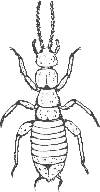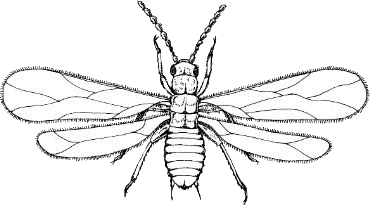Zoraptera
Pronunciation: [Zor⋅AP⋅ter⋅a]
Pronunciation: [Zor⋅AP⋅ter⋅a]
Common Name: Zorapterans / Angel Insects
Greek Origins of Name: Zoraptera, derived from the Greek “zor” meaning pure and “aptera” meaning wingless, was given to the order before winged forms were discovered.
Hemimetabola, i.e. incomplete metamorphosis (egg, nymph, adult)
Polyneoptera, closely related to Orthoptera; some entomologists believe they may represent an evolutionary link between Polyneoptera and Paraneoptera (particularly Psocodea).
Rare. Usually found only in association with rotting wood or piles of aged sawdust. Known to occur in all biogeographic regions except the Palearctic. Approximately 2 families and 2 species in North America and 2 families and 44 species worldwide
Members of the order Zoraptera are small (less than 4 mm) and usually found in rotting wood, under bark, or in piles of old sawdust. They live in small aggregations and appear to scavenge on spores and mycelium of fungi, or occasionally, on mites and other small arthropods. Little more is known about their biology. Some Zoraptera are blind, pale in color, and wingless, while other members of the same species may be darkly pigmented with compound eyes and wings. The winged individuals are rather uncommon; they may be dispersal forms. The wings break off easily near the base, leaving only stubs.


The Zoraptera do not have any economic significance. They are rarely collected.
Zorotypidae — this single family includes all known species of Zoraptera.